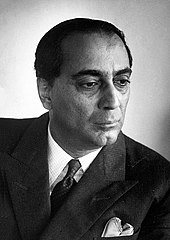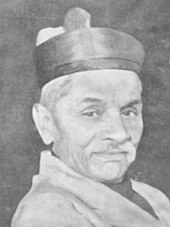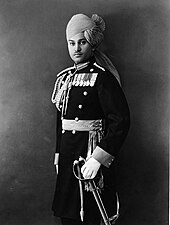The Padma Bhushan is the third-highest civilian award of the Republic of India.[1] Instituted on 2 January 1954, the award is given for "distinguished service of a high order", without distinction of race, occupation, position, or sex.[2] The recipients receive a Sanad, a certificate signed by the President of India and a circular-shaped medallion with no monetary association. The recipients are announced every year on Republic Day (26 January) and registered in The Gazette of India—a publication used for official government notices and released weekly by the Department of Publication, under the Ministry of Urban Development.[3] The conferral of the award is not considered official without its publication in the Gazette. The name of recipient, whose award have been revoked or restored, both of which require the authority of the President, is archived and they are required to surrender their medal when their name is struck from the register;[4] none of the conferments of Padma Bhushan during 1954–1959 have been revoked or restored. The recommendations are received from all the state and the union territory governments, as well as from Ministries of the Government of India, the Bharat Ratna and the Padma Vibhushan awardees, the Institutes of Excellence, the Ministers, the Chief Ministers and the Governors of State, and the Members of Parliament including private individuals.[3]
| Padma Bhushan | |
|---|---|
 | |
| Type | National Civilian |
| Country | India |
| Presented by | Government of India |
| Ribbon | |
| Obverse | A centrally located lotus flower is embossed and the text "Padma" written in Devanagari script is placed above and the text "Bhushan" is placed below the lotus. |
| Reverse | A platinum State Emblem of India placed in the centre with the national motto of India, "Satyameva Jayate" (Truth alone triumphs) in Devanagari Script |
| Established | 1954 |
| First awarded | 1954 |
| Total | 94 |
| Website | http://www.padmaawards.gov.in/ |
| Precedence | |
| Next (higher) | |
| Next (lower) | |
When instituted in 1954, the Padma Bhushan was classified as "Dusra Varg" (Class II) under the three-tier Padma Vibhushan awards, which were preceded by the Bharat Ratna in hierarchy. The original specification of the award was a circle made of standard silver 1+3⁄8 inches (35 mm) in diameter, with rims on both the sides. A centrally located lotus flower was embossed on the obverse side of the medal and the text "Padma Vibhushan" written in Devanagari script was inscribed above the lotus along the upper edge of the medal. A floral wreath was embossed along the lower edge and a lotus wreath at the top along the upper edge. The State Emblem of India was placed in the centre of the reverse side with the text "Desh Seva" in Devanagari Script on the lower edge. The medal was suspended by a pink riband 1+1⁄4 inches (32 mm) in width divided into three equal segments by two white vertical lines.[2]
On 15 January 1955, the Padma Vibhushan was reclassified into three different awards; the Padma Vibhushan, the highest of the three, followed by the Padma Bhushan and the Padma Shri. The criteria includes "distinguished service of a high order in any field including service rendered by Government servants" but excluding those working with the Public sector undertakings with the exception of doctors and scientists. The 1954 statutes did not allow posthumous awards but this was subsequently modified in the January 1955 statute. The design was also modified to the form that is currently in use. The current design is a circular-shaped toned bronze medallion 1+3⁄4 inches (44 mm) in diameter and 1⁄8 inch (3.2 mm) thick. The centrally placed pattern made of outer lines of a square of 1+3⁄16 inches (30 mm) side is embossed with a knob embossed within each of the outer angles of the pattern. A raised circular space of diameter 1+1⁄16 inches (27 mm) is placed at the centre of the decoration. A centrally located lotus flower is embossed on the obverse side of the medal and the text "Padma" written in Devanagari script is placed above and the text "Bhushan" is placed below the lotus. The Emblem of India is placed in the centre of the reverse side with the national motto of India, "Satyameva Jayate" (Truth alone triumphs) in Devanagari Script, inscribed on the lower edge. The rim, the edges and all embossing on either side is of standard gold with the text "Padma Bhushan" of gold gilt. The medal is suspended by a pink riband 1+1⁄4 inches (32 mm) in width with a broad white stripe in the middle.[3][4] It is ranked fifth in the order of precedence of wearing of medals and decorations of the Indian civilian and military awards.[a]
A total of twenty-three awards were conferred in 1954 followed by twelve in 1955; thirteen in 1956; sixteen in 1957; sixteen again in 1958, and fourteen in 1959, giving a total of 94 recipients in the first six years—including one foreign recipient awarded in 1955. Till 1959, individuals from nine different fields were awarded which includes twenty-six from literature and education, seventeen from civil service, twelve artists, ten from science and engineering, ten from social work, eight from public affairs, six from medicine, four sportspersons, and one from trade and industry.
Recipients








|
|
|---|
| Year | Recipient | Field | State |
|---|---|---|---|
| 1954 | Homi Jehangir Bhabha | Science & Engineering | Maharashtra |
| 1954 | Shanti Swaroop Bhatnagar | Science & Engineering | Uttar Pradesh |
| 1954 | Mahadeva Iyer Ganapati | Civil Service | Odisha |
| 1954 | Jnan Chandra Ghosh | Science & Engineering | West Bengal |
| 1954 | Radha Krishan Gupta | Civil Service | Delhi |
| 1954 | Maithili Sharan Gupt | Literature & Education | Uttar Pradesh |
| 1954 | R. R. Handa | Civil Service | Punjab |
| 1954 | Amarnath Jha | Literature & Education | Uttar Pradesh |
| 1954 | Ajudhiya Nath Khosla | Science & Engineering | Delhi |
| 1954 | Kariamanickam Srinivasa Krishnan | Science & Engineering | Tamil Nadu |
| 1954 | Hussain Ahmad Madani | Literature & Education | Uttar Pradesh |
| 1954 | Josh Malihabadi | Literature & Education | Delhi |
| 1954 | V. L. Mehta | Public Affairs | Gujarat |
| 1954 | Vallathol Narayana Menon | Literature & Education | Kerala |
| 1954 | A. Lakshmanaswami Mudaliar | Literature & Education | Tamil Nadu |
| 1954 | Maharaj Kr. Palden T Namgyal | Public Affairs | Punjab |
| 1954 | V. Narahari Rao | Civil Service | Karnataka |
| 1954 | Pandyala Satyanarayana Rau | Civil Service | Andhra Pradesh |
| 1954 | Jamini Roy | Arts | West Bengal |
| 1954 | Sukumar Sen | Civil Service | West Bengal |
| 1954 | Satya Narayana Shastri | Medicine | Uttar Pradesh |
| 1954 | M. S. Subbulakshmi | Arts | Tamil Nadu |
| 1954 | Kodandera Subayya Thimayya | Civil Service | Karnataka |
| 1955 | Fateh Chand Badhwar | Civil Service | Punjab |
| 1955 | Lalit Mohan Banerjee | Medicine | West Bengal |
| 1955 | Suniti Kumar Chatterji | Literature & Education | West Bengal |
| 1955 | Kamaladevi Chattopadhyay | Social Work | West Bengal |
| 1955 | Surender Kumar Dey | Civil Service | Delhi |
| 1955 | Vasant Ramji Khanolkar | Medicine | Maharashtra |
| 1955 | Sunder Das Khungar | Civil Service | Punjab |
| 1955 | Rameshwari Nehru | Social Work | Uttar Pradesh |
| 1955 | Prana Krushna Parija | Literature & Education | Odisha |
| 1955 | Madapati Rao | Social Work | Andhra Pradesh |
| 1955 | Maneklal Sankalchand Thacker | Science & Engineering | Delhi |
| 1955 | Attur Rangaswami Venkatachari | Civil Service | Tamil Nadu |
| 1956 | Rukmini Devi Arundale | Arts | Tamil Nadu |
| 1956 | Rajshekhar Basu | Literature & Education | West Bengal |
| 1956 | Dhyan Chand | Sports | Punjab |
| 1956 | Malur Srinivasa Thirumale Iyengar | Civil Service | Tamil Nadu |
| 1956 | Nawab Zain Yar Jung | Public Affairs | Telangana |
| 1956 | Pushpavati Janardanrai Mehta | Public Affairs | Maharashtra |
| 1956 | Cottari Kankaiyah Nayudu | Sports | Tamil Nadu |
| 1956 | Muthulakshmi Reddi | Medicine | Tamil Nadu |
| 1956 | Kanwar Sain | Civil Service | Rajasthan |
| 1956 | Vir Singh | Literature & Education | Punjab |
| 1956 | Kasturi Srinivasan | Literature & Education | Punjab |
| 1956 | Mahadevi Varma | Literature & Education | Uttar Pradesh |
| 1956 | Tiruvadi Sambasiva Venkataraman | Science & Engineering | Tamil Nadu |
| 1957 | Bhikham Lal Atreya | Literature & Education | Uttar Pradesh |
| 1957 | T. Balasaraswati | Arts | Tamil Nadu |
| 1957 | Alagappa Chettiar | Social Work | Tamil Nadu |
| 1957 | Hazari Prasad Dwivedi | Literature & Education | Uttar Pradesh |
| 1957 | Abid Hussain | Literature & Education | Uttar Pradesh |
| 1957 | Mushtaq Hussain Khan | Arts | Madhya Pradesh |
| 1957 | Lakshmi Menon | Public Affairs | Kerala |
| 1957 | Radha Kumud Mukherjee | Public Affairs | West Bengal |
| 1957 | K. Covilagam Kutti Ettan Raja | Civil Service | Kerala |
| 1957 | Andal Venkatasubba Rao | Social Work | Andhra Pradesh |
| 1957 | Shrikrishna N. Ratanjankar | Arts | Uttar Pradesh |
| 1957 | Shyam Nandan Sahay | Literature & Education | Bihar |
| 1957 | Govind Sakharam Sardesai | Literature & Education | Maharashtra |
| 1957 | K. A. Nilakanta Sastri | Literature & Education | Tamil Nadu |
| 1957 | Boshi Sen | Science & Engineering | West Bengal |
| 1957 | Siddheshwar Varma | Literature & Education | Chandigarh |
| 1958 | Salim Ali | Science & Engineering | Maharashtra |
| 1958 | Vijaya Anand | Sports | Uttar Pradesh |
| 1958 | D. P. Roy Choudhury | Arts | West Bengal |
| 1958 | Jeahangir Ghandy | Trade & Industry | Maharashtra |
| 1958 | Narayan Subarao Hardikar | Social Work | Karnataka |
| 1958 | Ariyakudi Ramanuja Iyengar | Arts | Tamil Nadu |
| 1958 | Allauddin Khan | Arts | Uttar Pradesh |
| 1958 | Kumar Padma Siva Shankara Menon | Civil Service | Kerala |
| 1958 | Arathil C. Narayanan Nambiar | Civil Service | Kerala |
| 1958 | Kuppali Venkatappagowda Puttappa | Literature & Education | Karnataka |
| 1958 | Poola Tirupati Raju | Literature & Education | Rajasthan |
| 1958 | Kamalendumati Shah | Social Work | Delhi |
| 1958 | Rao Raja Hanut Singh | Public Affairs | Rajasthan |
| 1958 | Rustom Jal Vakil | Medicine | Maharashtra |
| 1958 | Surya Narayan Vyas | Literature & Education | Madhya Pradesh |
| 1958 | Darashaw Nosherwan Wadia | Science & Engineering | Maharashtra |
| 1959 | Sisir Kumar Bhaduri[b] | Arts | West Bengal |
| 1959 | Ramdhari Singh Dinkar | Literature & Education | Bihar |
| 1959 | Ali Yavar Jung | Civil Service | Maharashtra |
| 1959 | Hansa Jivraj Mehta | Social Work | Maharashtra |
| 1959 | Pammal Sambandha Mudaliar | Arts | Tamil Nadu |
| 1959 | Tiruppattur R. Venkatachala Murti | Literature & Education | Tamil Nadu |
| 1959 | Tenzing Norgay | Sports | West Bengal |
| 1959 | Bhaurao Patil | Social Work | Maharashtra |
| 1959 | Jal Cawashaw Paymaster | Medicine | Maharashtra |
| 1959 | Dhanvanthi Rama Rau | Social Work | Maharashtra |
| 1959 | Nirmal Kumar Sidhanta | Literature & Education | West Bengal |
| 1959 | Kankanhalli Vasudevachary | Arts | Karnataka |
| 1959 | Bhargavaram Viththal Varerkar | Public Affairs | Maharashtra |
| 1959 | Ghulam Yazdani | Science & Engineering | Telangana |
Explanatory notes
References
External links
- Official website
- "Awards & Medals". Ministry of Home Affairs (India). 14 September 2015. Archived from the original on 9 February 2018. Retrieved 22 October 2015.